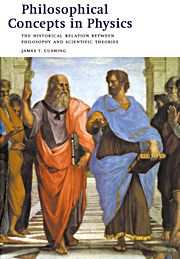 Philosophical Concepts in Physics
Philosophical Concepts in Physics Book contents
- Frontmatter
- Contents
- Preface
- Copyright acknowledgments
- PART I The scientific enterprise
- PART II Ancient and modern models of the universe
- PART III The Newtonian universe
- PART IV A perspective
- PART V Mechanical versus electrodynamical world views
- PART VI The theory of relativity
- PART VII The quantum world and the completeness of quantum mechanics
- PART VIII Some philosophical lessons from quantum mechanics
- PART IX A retrospective
- Notes
- General references
- Bibliography
- Author index
- Subject index
PART VI - The theory of relativity
Published online by Cambridge University Press: 05 June 2012
- Frontmatter
- Contents
- Preface
- Copyright acknowledgments
- PART I The scientific enterprise
- PART II Ancient and modern models of the universe
- PART III The Newtonian universe
- PART IV A perspective
- PART V Mechanical versus electrodynamical world views
- PART VI The theory of relativity
- PART VII The quantum world and the completeness of quantum mechanics
- PART VIII Some philosophical lessons from quantum mechanics
- PART IX A retrospective
- Notes
- General references
- Bibliography
- Author index
- Subject index
Summary
The beauty and clearness of the dynamical theory, which asserts heat and light to be modes of motion, is at present obscured by two clouds. I. The first came into existence with the undulatory theory of light, and was dealt with by Fresnel and Dr. Thomas Young; it involved the question, How could the earth move through an elastic solid, such as essentially is the luminiferous ether? II. The second is the Maxwell–Boltzmann doctrine regarding the partition of energy.
Lord Kelvin (William Thomson), Nineteenth Century Clouds Over the Dynamical Theory of Heat and LightNewton, forgive me; you found the only way which, in your age, was just about possible for a man of highest thought- and creative power. The concepts, which you created, are even today still guiding our thinking in physics, although we now know that they will have to be replaced by others farther removed from the sphere of immediate experience, if we aim at a profounder understanding of relationships.
Albert Einstein, Autobiographical NotesInformation
- Type
- Chapter
- Information
- Philosophical Concepts in PhysicsThe Historical Relation between Philosophy and Scientific Theories, pp. 223 - 224Publisher: Cambridge University PressPrint publication year: 1998